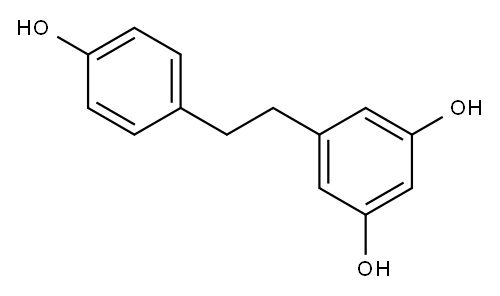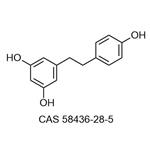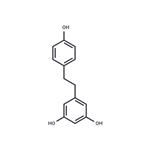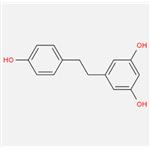Dihydroresveratrol (58436-28-5) is a metabolite of resveratrol produced by gut microbiota.1-3?Glucoronide conjugates are found in human urine after oral intake of resveratrol-containing dietary supplements.4?Dihydroresveratrol glucoside is a potent melanogenesis inhibitor in B16F0 melanoma cells.5?Inactive analog of resveratrol in induction of premature senescence.6
Dihydroresveratrol is a major metabolite of resveratrol that is produced by animal-associated bacteria, including the gut microbiota. Dihydroresveratrol and dihydroresveratrol monosulfate are detectable in urine. The physiological effects of dihydroresveratrol have not been investigated.
Dihydroresveratrol is a natural phytoestrogen.
ChEBI: Dihydroresveratrol is a stilbenol that is 1,1'-ethane-1,2-diyldibenzene with hydroxy groups at positions 1, 3 and 4'. It has a role as a xenobiotic metabolite and a plant metabolite.
1) Jung?et al.?(2009),?Interaction of dietary resveratrol with animal-associated bacteria; FEMS Microbiol. Lett.,?297?266
2) Bode?et al.?(2013),?In vivo and in vitro metabolism of trans-resveratrol by human gut microbiota; Am. J. Clin. Nutr.,?97?295
3) Jarosova?et al.?(2019),?Metabolism of Stilbenoids by Human Faecal Microbiota; Molecules,?24?E1155
4) Radco?et al.?(2013),?Semi-preparative isolation of dihydroresveratrol-3-O-?-d-glucuronide and four resveratrol conjugates from human urine after oral intake of a resveratrol-containing dietary supplement; J. Chromatogr. B Analyt. Technol. Biomed. Life Sci., 930?54
5) Oode?et al.?(2014),?Synthesis of dihydroresveratrol glycosides and evaluation of their activity against melanogenesis in B16F0 melanoma cells; Eur. J. Med. Chem.,?87?862
6) Faragher?et al.?(2011),?Resveratrol, but not dihydroresveratrol, induces premature senescence in primary human fibroblasts; Age (Dordr.),?33?555



